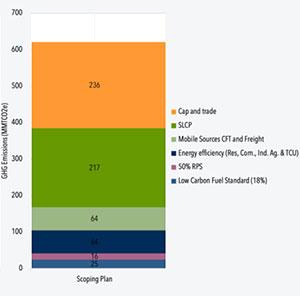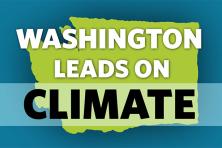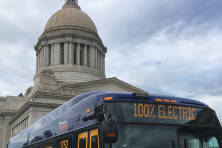Successfully tackling our climate challenge will require a mix of policies that includes investment, emission standards, and more. One important question is: how do we account for the harms of carbon pollution in our economy and hold accountable those responsible for them? Doing this will require grappling with the serious legacy of environmental racism that exists in our society, the result of both intentional and unintentional policies enacted by governments and supported by advocates over the years. This article describes Climate Solutions' approach to the Climate Commitment Act, Governor Inslee’s proposed cap-and-invest system, and other systems like it. There are other strong carbon policies under discussion this year, including a carbon fee, that we don’t discuss in this post.
Want to better understand how carbon taxes and cap-and-invest work? Check out our webinar from July 9, 2020 that describes both approaches (find the presentation Carbon Pricing 101 and its materials on this page).
The Washington Legislature is again debating carbon pricing with an eye toward generating revenue to invest in public transit, climate adaptation, reducing carbon pollution and more. This is a range of investments most people agree on—Climate Solutions and many partners are working to ensure that the investment plan that comes out of any carbon pricing measure conforms with principles developed by the many organizations coming together to create the Climate Alliance and the Environmental Priorities Coalition’s Clean and Just Transportation proposal.
But as always when carbon pricing is on the agenda, there is an active and at times intense debate on whether a cap-and-invest system or a carbon tax or fee approach is preferable to meet the demands of science and correct the disproportionate impacts on communities that most directly bear the costs of pollution. Climate Solutions' view is that either one of these systems can be designed well, to effectively cut carbon pollution and to benefit those communities that bear the most environmental burdens. Either can also be designed poorly, to provide the appearance of action while extending a legacy of pollution that is fast making our planet less habitable. The details matter.
Governor Inslee along with Senators Carlyle, Saldaña and others this year have proposed a new bill, the Climate Commitment Act, as part of an ambitious climate agenda. The Climate Commitment Act includes a cap-and-invest system as its centerpiece, a policy that creates a gradually reducing economy-wide cap on greenhouse gas emissions targeted to achieving a 95% reduction by 2050 with additional interim targets. While we think the policy as introduced needs a range of improvements, we see great potential for it to meet the needs of the moment and support a historic level of support for transit investments that connect communities to mobility, especially those who need it most, along with transportation electrification that we will need if we’re to achieve our greenhouse gas goals. There is a real risk that if the Climate Commitment Act doesn’t pass in some form this session, neither will a transportation and transit investment package—a framework that was carefully developed in close partnership with a range of partners within the Climate Alliance. We’re working hard to avoid that outcome.
Carbon taxes and cap-and-invest systems have much in common. Both are market mechanisms that reduce pollution by making major carbon emitters pay for the consequences of their actions, thereby incentivizing the adoption of clean sources of energy that have lower climate impacts. Both hold the largest sources of climate pollution in the state accountable for their outsized role in fueling the climate crisis and require them to contribute to the solutions we need. Both require complementary mechanisms to assure local benefits. The difference is that a carbon tax has legislators establishing the level of taxation, while cap-and-invest’s price is a function of the cap—the lower the amount of pollution allowed, the more entities covered by the policy bid up the price, leading to deeper pollution reductions. Both incentivize pollution reductions where they’re the cheapest, not where they’re the most beneficial, for example supporting low-hanging-fruit efficiency investments (which we also need!) instead of eliminating dangerous air toxics from cars in dense communities. This is why all carbon pricing systems need complementary mechanisms to ensure that benefits actually target and benefit communities of color and low-income communities who carry the highest burdens of pollution—including cleaning up what powers our transportation and advancing other ways to cut pollution quickly. We like that cap-based systems, when well-designed, provide certainty of emission reductions at the correct scale which carbon taxes do not—but both can deliver the emission reductions we need.
Nonetheless, we share some of the concerns expressed by those who object to cap-and-invest and agree that as introduced the bill is insufficient. As these conversations continue, we want to share how we think about some of the objections that have been raised.
OBJECTION: Cap-and-invest doesn’t effectively reduce the burden of air pollution.
Critics of cap-and-invest point out that California’s cap-and-trade system, as it’s called in that state, has not led to deep reductions in in-state carbon emissions or in the criteria air pollutants like NOx, ozone, particulate matter and others that often go along with them. Instead, the bulk of reductions from cap-and-trade have so far come from reducing the use of out-of-state coal generation to supply the state’s electricity. That’s true, but it’s not evidence that the system isn’t working. Crucially, a carbon tax would yield the exact same result. That’s because carbon pricing targets the most carbon intensive forms of energy first and the less carbon intensive ones later. The dirtier you are, the harder you fall. That means that carbon pricing alone mostly tackles carbon emissions—just as it’s designed to do—and addresses air pollution as an important co-benefit.
That’s why Climate Solutions has never been a carbon pricing only organization—we’ve always fought for those policies that yield emission reductions where they harm people most. With our partners we helped pass Clean Cars legislation in 2005 to help address transportation emissions that cause the most direct harms to directly impacted communities. We helped achieve the landmark Transalta closure agreement that is on track to shutter Washington’s last coal plant; we worked with King Country Metro and Portland’s TriMet to secure a commitment to end the purchase of diesel buses; we supported the zero-emission vehicle mandate to push fossil fuels out of vehicles entirely; we’ve advocated for a multitude of transit measures in both Washington and Oregon; helped pass hundreds of millions of dollars in financial support for vehicle electrification; were part of a major effort to stop coal exports off the West Coast, and more. It’s why we passed the Clean Fuels Program in Oregon and have worked for a decade to pass the Clean Fuel Standard in Washington, and will keep fighting until it reaches the governor’s desk.
And it’s why, in addition to carbon pricing, this year we’re supporting building electrification policy to cut exposure to dangerous indoor methane gas emissions that lead directly to childhood asthma, especially among apartment dwellers; reforms to the Growth Management Act to make sure we’re planning our neighborhoods in ways that protect people; Buy Clean/Buy Fair legislation that will leverage Washington State’s buying power to benefit workers and frontline communities far beyond our borders; equitable and climate-oriented transportation investments; and the HEAL Act to make sure that environmental justice is embedded deeply within state government’s work. Not one of these policies is enough by itself—together, they are transformative.
Both carbon taxes and cap-and-invest offer the prospect of raising billions of dollars to fund Green New Deal-type investments that will lead to in-state benefits. Both incentivize green solutions and penalize pollution, but cap-and-invest pairs this with a firm limit on the amount of greenhouse gases our state can actually emit. It’s past time we did this.
All of that said, we’re encouraged that the available evidence supports the conclusion that, whatever its limitations, when it comes to air pollution, California’s cap-and-trade system has led to air quality improvements in disproportionately burdened communities. A working paper published in May 2020 by the National Bureau of Economic Research combined observed emissions from facilities with a pollution transport model, and then compared the pollution impact of facilities that are and are not regulated by California’s cap-and-trade system. The researchers measured the “environmental justice gap,” the gulf between air pollution experienced in burdened communities versus other areas in the state. They found that prior to the institution of cap-and-trade, the environmental justice gap was widening—that impacted communities were gradually getting worse off compared to other parts of the state—and afterwards the gap has steadily narrowed. The research concluded that "California’s [cap-and-trade] program has reduced the [environmental justice] gap in NOx, SOx, PM2.5, and PM10… by 21-30%.”
Now, there are some who criticize this study, notably this useful post by Danny Cullenward and Kate Valenzuela, but even they conclude: “The better alternatives [to California’s cap-and-trade system] are (1) a stronger cap-and-trade program, (2) more direct regulations on polluters, and (3) more of both kinds of policy.” We couldn’t agree more and continue to work to achieve those outcomes.
The fact remains that we haven’t seen studies that indicate that cap-and-trade in California has led to increases in pollution in overburdened communities. Concerns about disproportionate pollution impacts mostly come from a September 2016 preliminary assessment published by the University of Southern California along with similar research published since then. The report examined impacts from less than two years of the program in 2013 and 2014 and makes comparisons to observed emissions in 2011 and 2012. This analysis is inconclusive. In 2013-2014, the cap-and-trade program didn’t cover a significant share of emissions, including transportation. The report also doesn’t seek to control for differing macroeconomic conditions—economic activity in 2011 and 2012 was still hampered by the Great Recession and had recovered by 2013-2014—or for other energy market events—the closure of San Onofre Nuclear Generating Station in 2013 led to increased fossil fuel power plant dispatch. While these changes have real impacts on people, neither are related to cap-and-trade. And finally, this research brief made no comparison to a carbon tax, meaning that it doesn’t state or imply that the results would have been different had the state chosen that path instead.
From our perspective, a cap-based system has certain advantages when considering local pollution impacts. Previously proposed versions of carbon taxes—including both 2018’s SB 6203 and I-1631—provided full exemptions for a wide class of industrial facilities. Under that approach, those facilities would have no requirement to reduce emissions. Under the governor’s Climate Commitment Act, however, while these facilities would receive reduced-cost compliance in order to prevent their production from shifting out of state where emissions would be higher, they must still exist under the overall cap, meaning that as the state gradually ramps down emissions, they must do so as well. Additionally, the likelihood that a Washington carbon tax system would exempt electricity means even less coverage compared to a cap-based approach.
The Climate Commitment Act includes a number of improvements over California’s system, including regular reviews of the reduction trajectory, creation of a permanent environmental justice oversight board, the creation of an emissions containment reserve and more. That’s the benefit of going second—we don’t need to settle for California’s exact approach, we can learn from their experiences and improve on them. Even with these improvements, we’re asking legislators to go further, including a reduction in the amount of offsets allowed under the proposal, investment set-asides for environmental justice communities, linkage limitations, and much more.
OBJECTION: Under cap-and-invest, covered entities don’t have to reduce their emissions—they can just buy more allowances.
We don’t think this is accurate and believe it actually describes carbon taxes more accurately. While a facility under a cap-and-invest system can pollute as long as it continues to acquire allowances, the total number of allowances is limited and steadily goes down every year. This means that there is a limit, both in terms of cost and total amount of allowances, that the economy and any one facility can acquire.
Under a carbon tax, however, as long as a facility can afford the tax rate, they can continue emitting—there is no limit to the amount of emissions that any one facility or the economy as a whole can produce. For industrial emitters, the likely exemptions they will receive under a carbon tax proposal means there isn’t a cost limitation for their emissions either—the policy contains no incentive for reduced emissions unless the state of Washington pays them to cut pollution directly. That does not mean that a carbon tax can’t achieve the same level of reductions as a cap-based system, but it does mean that doing so relies on legislators correctly guessing and being able to enact the necessary price level to achieve them.
OBJECTION: Offsets are a corporate give-away that prevent real reductions
This is a tough one. It is true that offsets offer covered parties a lower cost way of complying for a limited subset of their obligations, and it is also true that in the past they have often been unintentionally poorly designed so as to not yield actual reductions. Both of these are causes for deep concern and any offset protocol allowed under this or any other system needs to be subject to rigorous and regular quality checks. But the presence of offsets in programs like these is generally not intended as a corporate giveaway. For example, the Kyoto Protocol included a type of offset called a Clean Development Mechanism (CDM) the intent of which was to have wealthy countries provide direct financial support to the developing world to aid sustainable and equitable growth for the Global South. CDMs were initially rife with issues, however, which the United Nations and other parties have worked to steadily address. These mechanisms were developed with the best of intentions, but good intentions or not, the harms from falling short are real and they are serious.
Another reason to include offsets in cap-and-invest systems is to generate direct investment in natural resources and the development and maintenance of carbon sinks, both necessary for long-term climate stability. One of the largest offset agreements in California’s market is actually based in Washington State—a sequestration and forest stewardship agreement with the Colville Indian Reservation in the northeastern corner of the state. Another significant agreement was finalized last year with the Warm Springs tribes in Oregon. Other tribal governments in the past have expressed interest in these approaches too.
Tribal governments are important voices as the Legislature decides whether and how to include offsets. If offsets remain part of the proposal, it is important to Climate Solutions that their use should be limited to 6-8% of compliance or less, that they are tightly regulated, and that a significant share of them yield direct environmental benefits to the state. We’ve also suggested to legislators that the Climate Commitment Act withdraw allowances from future compliance periods in volumes equal to offset use, ensuring that even when they are used, offsets do not impact the integrity of the cap, along with a variety of other changes to prevent unintended consequences from their use.
OBJECTION: Cap-and-trade hasn’t been an important part of California’s emission reductions—other programs have done more of the heavy lifting.
It would be a bad idea to rely on one program to achieve all emission reductions, and California’s cap-and-trade system has both directly yielded its own reductions and provides funding for other programs that have produced deeper reductions. Funded by the revenues from their cap-and-trade system, California has raised over $5 billion since its inception, dedicated a third of those revenues to environmental justice communities, and enabled significant investments in clean energy and climate adaptation—resources we just don’t have right now in the Pacific Northwest. Between 2013 (the first year of cap-and-trade) and 2018, California emissions declined by about 22 million tons, in part through the program and the investments that it has funded. Unlike Washington, California is emitting less than it did in 1990. Their program can and should be more stringent, but it has yielded benefits already.
Reductions by Measure (2021-2030).
Beyond those direct benefits, California, like Washington, intends to rely on a range of programs and policies to cut greenhouse gas emissions and secure other benefits. These programs in California include the Clean Car standards (Washington adopted in 2005), electricity requirements (Washington adopted CETA in 2019), the Zero Emissions Vehicle mandate (Washington adopted in 2020), restrictions on short-lived pollution (Washington passed an HFC prohibition in 2019 and has new legislation to go further this year), and others. Washington has also passed the Clean Buildings Act which will contribute to greater energy efficiency.
And while California anticipates that cap-and-trade will be the single largest contributor to carbon reductions between 2021 and 2030, it plans to rely on a combination of multiple policies to achieve its goals. No one program can do the job alone.
OBJECTION: Some big companies, including some oil companies, support cap-and-invest.
Yep, that’s true. Climate Solutions and many of our partners have been working for carbon pricing, including a cap-and-invest system, for many years and long before large businesses started coming around to some of these policies. The simple reality is that climate action has arrived as a political issue because of intense public support for action and growing anger at corporate obstruction. More and more companies are being pushed by their employees to do better, and more of them see a failure to support action to be a public liability they just can’t afford. Even the worst offenders feel the need to explain how they’re contributing to the solution, which at times is simply greenwashing and at other times is a sincere effort to head off the crisis we face.
Among those this year is BP, a large multinational oil company. Supporting carbon pricing in Washington doesn’t atone for the company’s incredibly long history of harm—from climate disinformation, to causing irreparable harm from profit-motivated negligence in the Gulf, to the tens of millions it spent defeating Initiative 1631. At the same time, just because they have come around on a policy that we have long supported, doesn’t mean we’re going to walk away. If we did that, many of our greatest climate successes would never have come about.
The most significant climate policy this state has ever adopted is the Clean Energy Transformation Act (CETA), which will require 100% clean electricity by 2045. After years of heated disagreement, CETA passed in 2019 with no opposition from utility companies and the support of most, including those who rely on significant amounts of fossil fuels today. Should we have abandoned our support for that policy because of that? No—it was a great policy when businesses disagreed with us, and it was still a great policy when they came around.
The same applies to both cap-and-invest and carbon taxes. For decades, companies of all stripes opposed these policies with every dollar they had—now some are beginning to see the light. In 2019, Phillips 66, the fourth largest U.S. oil company with over $100 billion in annual revenue, testified in the Washington Senate that it prefers a carbon tax to a cap-and-invest system. This year, the Western States Petroleum Association, the country’s oldest oil advocacy group that includes among its members Chevron, Exxon, and others, came out in favor of a carbon tax (it continues to oppose cap-and-invest). Does that mean our past support of Initiative 1631 was mistaken? Does that mean that those folks that currently prefer a carbon tax got it wrong? No, it doesn’t.
Here’s our commitment—our position on any piece of climate legislation will rely on what we learn from our close and valued partners and on our own analysis of the policy and existing research on emission reduction best practices. It won’t rely at all on what BP or any other large business prefers. We’ll support those policies that in our judgement will effectively cut carbon pollution and do so in a way that prioritizes frontline communities who bear the burdens of climate change and fossil fuel pollution.
We think that with further improvements, the Climate Commitment Act can be that kind of policy, and in the process enable the most transit-forward, climate-smart transportation investment package this state has ever seen. We’re asking the Legislature to limit the use of offsets, dedicate at least 35% of all investments to overburdened communities, improve the integrity of the emissions limits, and other important changes.
This legislative session offers an incredible opportunity to make progress on climate—every year wasted really matters now. We’re focused on making that a reality. If we can secure the necessary changes to this bill, like the ones described above and others, we’ll support it all the way to the governor’s desk. If we can’t, we won’t—simple as that.





